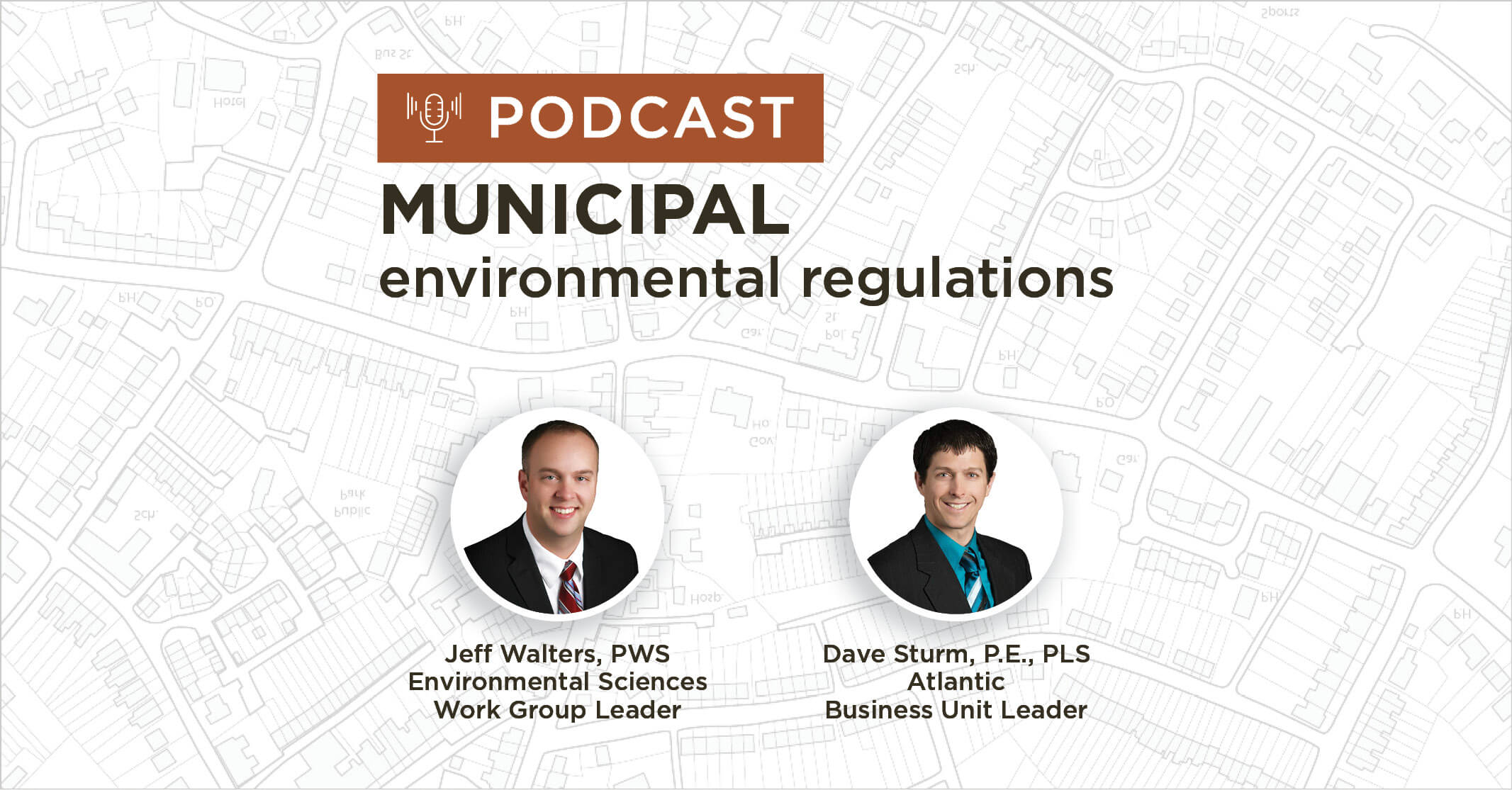Regulation is Increasing for Municipal Projects
The standards of safety are constantly changing at the federal and state levels. Therefore, suppliers of environmental services must meet these changing standards. Environmental regulations are evolving rapidly, and municipalities worldwide have experienced a significant increase in regulation. This increase not only includes new rules but also more strict and uniform enforcement. Mass investments in environmental protection can enhance the performance levels of municipalities, making communities safer, and ensuring that improvements do not harm the environment. Being prepared for changing regulations can significantly reduce the time it takes to start or continue a project.
Our experts are well aware of the regulations that affect projects and the necessary approvals that need to be taken before starting a project. This knowledge ensures that your project’s funding and time are not wasted. In this podcast, Environmental Scientist Jeff Walters, PWS, hosts Atlantic Business Unit Leader Dave Sturm, P.E., PLS, to discuss regulations regarding municipal environmental compliance and the available federal funding and how it may be affected.
Podcast Agenda
- Understanding Environmental Regulations (0:18)
- NEPA & Historical Studies for Federal Funding (3:13)
- Snyder’s Role in Municipal Projects (6:03)
- Environmental Regulation Trends for Municipal Projects (7:30)

Jeff Walters, PWS
Environmental Sciences Work Group LeaderJeff Walters, PWS
Environmental Sciences Work Group LeaderWetland & Stream Delineation & Mitigation, 404 Permitting, Natural Resources Surveys, Lake & Stream Restoration

Dave Sturm, P.E., PLS
Atlantic Business Unit LeaderDave Sturm, P.E., PLS
Atlantic Business Unit LeaderMunicipal Engineering, Street Design, Trail Planning and Design, Site Planning, Land Development, Airport Improvements, Project Management
Understanding Environmental Regulations
Jeff Walters (0:18)
Dave, what’s the biggest industry issue pertaining to environmental regulations these days with you?
Dave Sturm (0:24)
Well, from the municipal engineering side, I think it’s mostly a lot of our clients who don’t understand what environmental regulations are out there and regulations they have to follow. Specifically speaking of Jeff, you’re familiar with that City of Atlantic Bull Creek project that we’re working on. It’s a small drainage way through town that starts at a storm sewer, and then the city wants to enclose that in a pipe. After some discussions with your group and submittal to the Corps (U.S. Army Corps of Engineers), we realized they’d call that a Water of the U.S., and we can’t do what the city wants.
So we start working with you guys to look at the bat habitat survey and wetland delineations and all those different aspects that go with trying to accomplish something that the city’s been trying to do for years, and that improves that drainage area through town. One of the biggest things for them to understand is they have to follow those rules, and there’s not much they can do about it. We rely on your group to help us get through those requirements. That’s a big hurdle for cities to accomplish.
Jeff Walters (1:26)
I think one of the fundamental issues that clients all over our industry, especially within the municipal sector, is just that good educational background of the environmental regulations that they need to follow. A lot of the municipalities are great at understanding public water supply and wastewater supply or wastewater regulations.
When it comes to these more nebulous issues where you have threatened endangered species, who knew in a particular city that they can’t cut down trees because there’s a bat issue? That can become a very sticky topic when, in the 11th hour, we’ve got a contractor ready to go, and the City Engineer and Public Works want to get those trees cut down, and we got to tell him, “Hey, let’s slow down there.” Let’s get the studies done and make sure that we are not impacting the Endangered Species Act in this case.
Dave Sturm (2:26)
That’s exactly what we dealt with here in Atlantic. If you recall, they had a stream bank that was collapsing, and it was basically eating into that property owner’s yard, and they wanted to go in and fix that and remove trees. They can’t. They have to meet all these requirements. It takes a while, but we finally get them to understand and realize what regulations are out there. With your help, we were able to accomplish that.
Jeff Walters (2:47)
We have those cases where if it’s an emergency, we can talk to the regulatory agencies like the Corp of Engineers, DNR, EPA, and Fish and Wildlife Service and get the approvals real quickly when it is an emergency. We’ve done that before, and the municipalities and the agencies are okay with that. We try to get ahead of the problem before it really becomes a problem.
NEPA & Historical Studies for Federal Funding
Jeff Walters (3:13)
So, what are some of the other common environmental hurdles that you and your clients tend to work through on a day-to-day basis?
Dave Sturm (3:21)
When we get into federal funding on some of our projects, we have to do those NEPA studies and those historical studies that you guys again help us with. Bedford is the example here. They’re reconstructing a road in that old part of town, and they just said we have to check for artifacts of historical significance and do a cultural resources investigation. It’s hard for the city to understand. This area of town has been developed for a hundred years, and they want to rebuild a road. They kind of ask the question, “Why do we have to go through this?” It doesn’t seem to make sense to them, but we do those studies, and we help them through and meet those federal funding requirements, and they’re really appreciative.
Jeff Walters (4:02)
Yeah. Federal funding is a challenge. The cities get this pot of money and think they’re off to the races to get the roadway improved upon or a bridge or sanitary sewer line. Then, they start reading the fine print. Or before they can even get that money, they just spent a lot of money potentially on these investigations, and their pot of money dwindles a little bit. It helps out when we can get in early. Get in often. Help minimize impacts. Help you with your preliminary and final design to avoid those impacts. So that more money from the feds and the state can be spent on these types of projects.
NEPA is an enigma, too. Some of these smaller cities that don’t have state or federal roads aren’t used to working with those agencies on a day-to-day basis. When we have smaller communities with various state funds through Iowa DOT or Iowa DNR, they have those conditions and stipulations that require environmental documentation and clearance first. We will do everything that we possibly can to keep those projects moving ahead and those clients happy.
Dave Sturm (5:20)
Right, and getting in early is key. As you said, Jeff, cause it’s good to let the client know that this free money isn’t free. There are a lot of additional costs associated with it. That’s a good comment about getting in early.
Jeff Walters (5:33)
Yeah. It’s important to make sure that we explain to the cities and clients to make sure we expand the dollars needed to include not only design and the construction but all those associated costs that include environmental documentation, cultural resources, survey, and geotechnical. A lot of those tasks can be paid for by state and federal funds.
Snyder’s Role in Municipal Projects
Jeff Walters (6:03)
How do you think the Environmental Business Unit at Snyder can further support your clients and projects?
Dave Sturm (6:10)
Well, Jeff, the greatest part I like about it is that we have you on staff. I can just call you up and not think about it after that. I don’t have to worry about it getting done and getting done right. So that’s the best part about having you as an extension to our staff here in Atlantic. We have your guys’ abilities and your staff at our disposal to use. So it’s a great fit to have you guys centralized in Ankeny and be able to help all the Business Units as you do.
Jeff Walters (6:38)
I certainly appreciate the accolades there. We serve a lot of clients, but the internal client can certainly be one of the biggest ones. We want to make sure to support your Business Units and other Business Units within the firm to make sure our clients are doing the right thing.
Dave Strum (6:56)
Our clients also like Jeff, that we’re able to provide these services in-house, where we can become that full service to the municipality and not have to rely on outside consultants for that work.
Jeff Walters (7:08)
Yeah. I agree. We try to do everything we possibly can house, and when we do have that need for outside services, we’ve got a wealth of resources and our sub that we’ve worked for 20-plus years that we really consider an extension of our team to make sure that your clients are getting their projects done.
Trends in Environmental Regulations for Municipal Projects
Jeff Walters (7:30)
What are some foreseeable changes that you anticipate within your client portfolio and the municipal industry as a whole?
Dave Sturm (7:39)
The changes I see going forward are probably just going to become stricter. I don’t think they’re going to loosen these changes in environmental regulations. I think we’re going to have to work with our clients to help them anticipate having further environmental regulations on their projects going forward. It’s something that we need to move with the requirements and help the city make those adjustments.
Jeff Walters (8:03)
Dave, you have a good point there, and that’s a trend that we hear from a lot of clients and a lot of consultants within our team: “Man, these rules just aren’t going away. What’s going on here?” And the reality is our resources start to dwindle. We start losing our forest areas, our wetlands, our natural areas. We have governmental entities that are really making it tougher, and it’s our job to make sure that we understand the rules and regulations and we can explain that to you. Help you support your clients through means of memos to you and in-person conversations with the clients. We try to do webinars and attend conferences to make sure that we’re reaching out to our clients and we’re understanding well ahead of time when the clients face these issues.
Dave Strum (9:01)
I’m in the same boat as these cities, some of these requirements. I just can’t believe it. I’ve stressed that to you before, Jeff. You know, that one in Bedford. I’m just like, wow, I just can’t believe it. We can’t even rebuild this road without going through this stuff. Federal requirements will do it to us.
Jeff Walters (9:20)
The last thing that we want to do is get our clients in trouble with the feds or the state because they wanted to miss a step. They thought it would be easy to circumvent the law when sometimes these permits are really easy to get. It’s just to fill out some paperwork and submitting to these agencies, and we get our permission within a couple of weeks. Sometimes weeks seem like years to the clients, but at the end of the day, when we have the proper documentation, our clients really are better for it.
Dave Sturm (9:53)
A lot of times, they base those decisions on cost as well. When it comes right down to it, costs shouldn’t be a factor in that they need to follow the letter of the law.
Jeff Walters (10:01)
Yeah. I appreciate it when clients are concerned with the bottom dollar. Especially for municipal clients, those dollars are generally tax dollars. They want to make sure every dollar spent is well spent so their city can afford projects and not just spend money to spend money.
Well, Dave, I appreciate your time here. I thank you for the insights that we have on the municipal clients, and I hope to be able to support you in the future.
Dave Sturm (10:36)
Sounds good. I appreciate it.
Jeff Walters (10:38)
Thanks, Dave.

